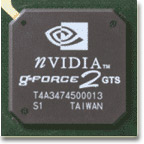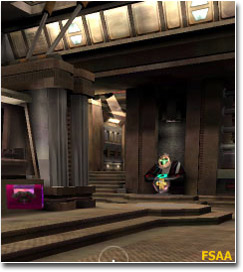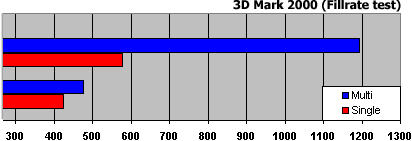
Nowadays, we are receiving the new graphic cards that are using GeForce2 GTS (NV15) processor. Just after LeadTek Winfast GTS2 we now have Asus V7700. Just like GeForce 256, the first samples of the producer’s cards, which use NV15, are the clones of the Nvidia’s reference cards. For the time being we can say that Asus, LeadTek and Elsa’s graphic cards are same J. Only heat sink and fan types are differing. The idea is to save time by keeping the design same to get into the market as quick as possible. Some producers even don’t modify the drivers. But as time passes you start to notice the differences in the cards. As Video In/Out, 3D glasses and etc. are added, the design changes. V7700 may differ from the reference design by the Winbond W83781D chip, which is used for Hardware Monitoring and the hardware monitoring system but in fact there was already a space on PCB where Winbond W83781D was installed J. Smart Doctor manages this monitoring system on V7700 like in V6x00 series.

So the fan speed, AGP voltage and temperature of the card are kept under control. If any of these values deviate from normal then the system interferes automatically. This is a lovely property for overlockers. Briefly this hardware monitoring system is very similar to the V&x00 cards. V7700 doesn’t have 3D glasses and Video I/O like V6600Pure but I guess v7700Deluxe will have. The first thing that takes your attention is the circular fan and heat sink. I don’t know if these designs have any superiority but as far as I see both models can keep NV15 cool enough. You get the full versions of WinDVD based Asus SoftDVD 2000, the demo cd which contains full versions Drakan and Rollcage games, 12 popular game demos and Asus’ driver cd.
200Mhz (clock speed) x 4 (way rendering pipeline) x 2 (two textures at each pipeline) = 1600Mpixel
This fillrate of 1.6 GigaPixel is about four times of NV10’s 480 Mpixel and is seriously a respectable ratio. NV15 is also 66.6% faster than NV10 in clock frequency and operates at 200 MHz. They have reached this speed using the advantages of 0.18-micron technology and it is possible to reach higher speeds. NV15 operates with 166Mhz DDR Rams and they have 5.3 Gig/s bandwidth. However mathematically a bandwidth of 7.5 Gigs/s is needed to feed a processor of 1.6 Gigapixel fill rate and NV15 may have troubles in future because of Rams transfer rate.
The abbreviation GTS at the end of NV15 stands for “Giga Texel Shader”. GigaTexel is named after the 1.6 Gig/s fill rate, and the Shader at the end is absolutely a new technology. With this technique, so called NSR (Nvidia Shader Rasterizer), NV15 can manipulate 7 separate effects like “shadow maps, bump mapping (EMBM, Dot Product 3, and embossed), shadow volumes, volumetric explosion, elevation maps, vertex blending, waves, refraction and specular lighting” at once and with pixel precision. The greatest breakout is per pixel rendering which is trying to improve the image quality. Textures are calculated per each pixel and mappings are made more realistic. When the hardware supported above effects are added and manipulated in pixel precision, the image quality of NV15 gives results of image quality like the pictures below.

Another improvement made in the search of image quality is FSAA (Full Screen Anti-aliasing) the best way for you to understand anti-aliasing is to take a look at the pictures below. The frame on the left is a picture taken from NV15 Demo with out FSAA. On the right you see the OpenGL with FSAA on. Nvidia chose the easiest and fastest way to make FSAA. The image to be antialiased is firstly rendered for a higher resolution than the original. (This ratio can be x1, x1.5, x2, and x4) And then it is reduced according to the ratio of enlargement. So you get an antialiasing also in the ratio of x-y interpolation.

FSAA is similar to the image size tool of Photoshop. Nvidia is also resizing the image with FSAA like the way photoshop does. Offcourse it is the system performance that slows down with these calculations. As you see in the graphics below while GeForce 2 is 2 times faster than NV10 at 16 bit, 800×600 and FSAA on, this ratio greatly decreases at 32 bit. NV15 supports FSAA with its hardware but I guess the appropriate drivers could not settle down yet. Just like the release of Detonator series and the difference between 3.xx and 5.xx drivers of GeForce256. There will be improvements in the new generation drivers for sure.
Although the drivers are not good enough, NV15 gives faster results on the classical Nvidia TreeMark demo with respect to the previous ones. You can see that it is 30-40% faster from the graph below. (In this OpenGL demo there is a scene of 35820 polygons and 4 light sources.) Although TreeMark, which mainly tests T&L engine and OpenGL, is not optimised for NV15, the result is acceptable. A more complex version of TreeMark for NV15 will be released in the near future.
NV15 is about 15-20% faster in 3D Mark2000 which makes more tests and compares more specs to give a grade however they doesn’t exceed a percentage of 30%. Briefly it is far behind the rate I expected but I think that this will improve in the future since it is a reference product and the drivers are not optimised.
We face a different situation in Quake Arena. You don’t see much difference in standard Demo001 at 32 bit but at 16 bit and high resolutions the difference increases rapidly. It is somehow funny in Nvidia’s NV15Demo. This is a special level prepared for NV15. High values of polygon number, texture quantity and resolution are used. The scene is also impressing but if you tend to compare NV10 and NV15 you will be surprised.
It gives similar results at all resolutions. As you see above each of the three cards’ results deviate only 1-2 frames and under normal circumstances this is not reasonable. Maybe the processor can’t feed NV15 good enough. Although my processor is 733Mhz PIII550E, it still builds up problems. Yet OpenGL doesn’t work independent of API and DirectX is highly dependent on CPU in some calculations. This may be the reasonable cause of these similar results. But I guess at 32 bit Ram transfer rate has more priority than CPU’s rate.





3D Mark 2000’s fillrate measurements verify what has been told. As you see above, at 576 Mpixel and multitexturing mode, V7700 is four times faster than V6800 with 1192 Mpixel. This fill rate is even faster than Voodoo5500 of 3DFX,which uses VSA100 chip to for SLI mode. Despite the fact that most people think that fillrate is the most important of all; I think that we don’t have to increase this amount any longer.
The rate is too much for a home user. Faster 3D systems are not needed. 85 fps for a game like Quake III arena at 1024×768 resolution is really an exaggerated rate and needless for the 90% of users. The majority use 15’’ monitors, some 17’’ and the people who use 19’’ or 21’’ monitors are the minority. Thus 1024×768 is still the ideal resolution. The advantage of GeForce2 GTS is not its speed. GeForce256 was already fast enough for home users. I think the pixel sensitive calculation and the shader effects, which are fully compatible with DirectX 8.0 is the plus. It will be more logical for producers to increase image quality rather than dealing with speed, and this is what Nvidia did.
PIII 550E (733Mhz O/C)
ABIT BE6-II (QY BIOS)
Asus AGP-V7700 (BIOS 2.15.05.07, v4.12.01.0516, 200/333Mhz)
Asus AGP-V6800 (BIOS 2.10.02sba, v4.12.01.0516, 120/301Mhz)
Kingston KVR PC133 128Mb
IBM DJNA 341350 UDMA66 HDD
TOSHIBA SD-M1212 DVD 1r22
SB Live! (Lw3.01)
Windows 98 SE (4.10.2222A)
DirectX 7.0 (v4.07.00.716)
3D Mark 2000 (build 335)
Quake III Arena v1.16n
Nvidia Grove

